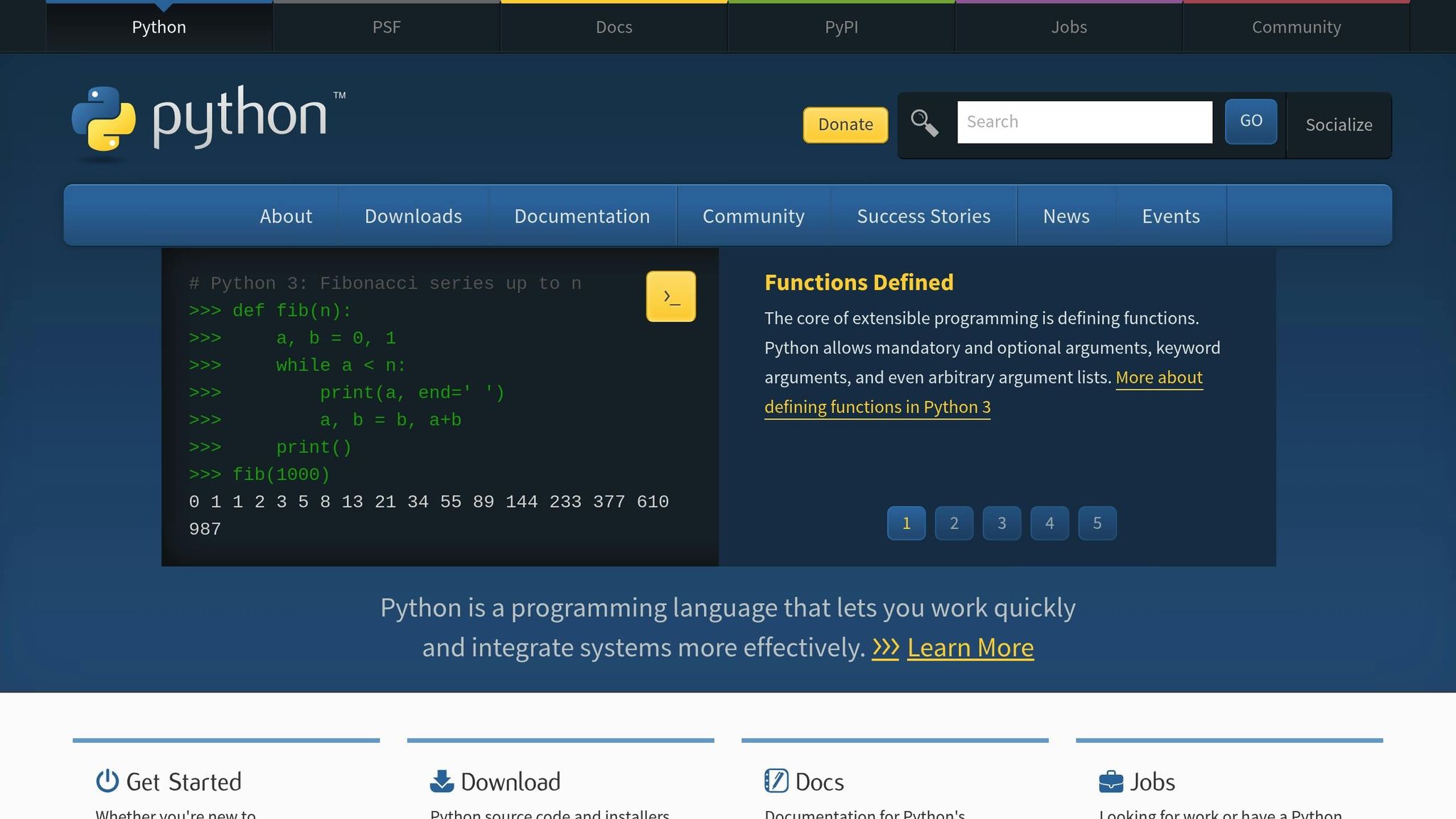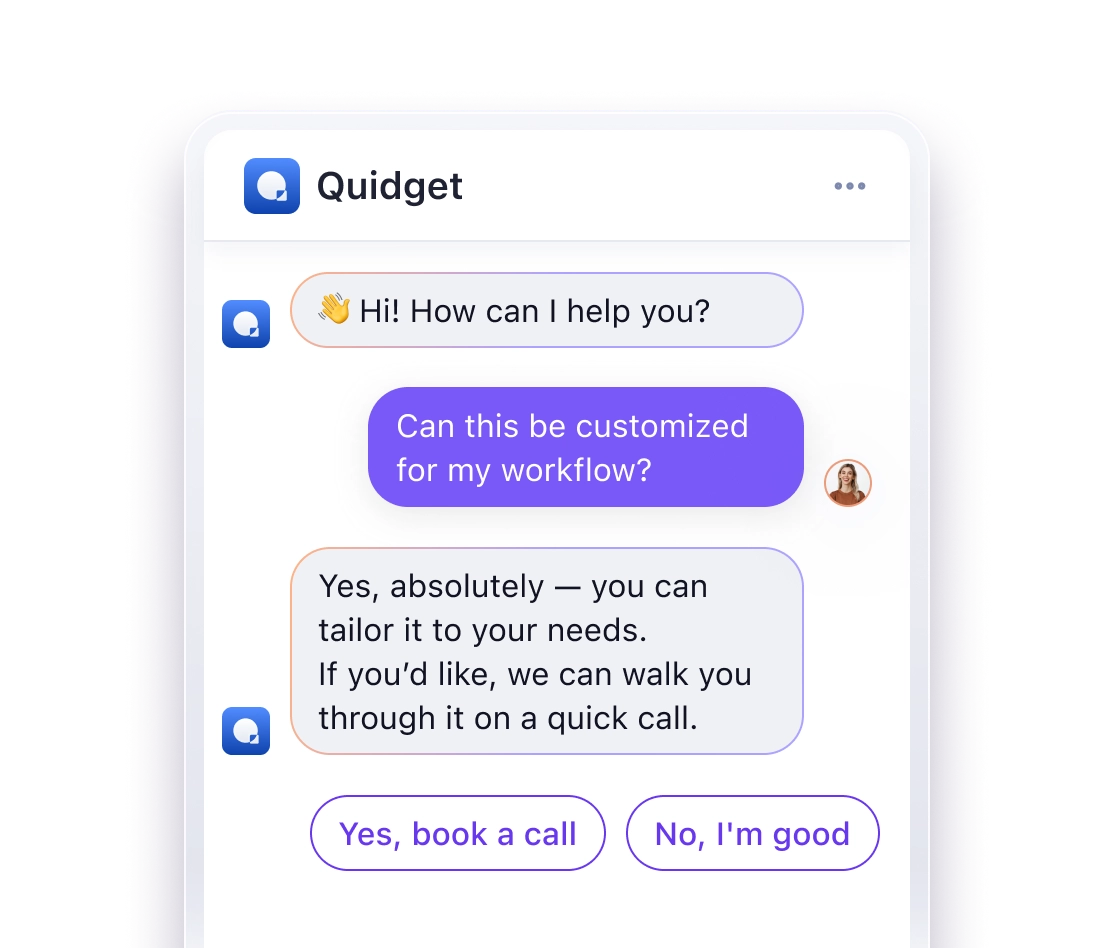Want to build an AI chatbot with Python? Here’s how you can do it, step-by-step.
Python makes chatbot creation simple with its clear syntax and powerful libraries like NLTK, SpaCy, and ChatterBot. This guide covers everything you need to know, from setting up your environment to training your chatbot and adding advanced features like intent recognition and context tracking.
Key Steps:
- Set Up Python: Install Python 3.8+, set up a virtual environment, and manage dependencies.
- Install Libraries: Use libraries like ChatterBot (chatbot framework), NLTK (language processing), and SpaCy (text analysis).
- Train Your Chatbot: Train with pre-built datasets or custom responses for tailored interactions.
- Test & Improve: Test responses, refine user intent recognition, and add memory for context-aware replies.
- Deploy: Use Flask to integrate your chatbot with apps like Slack, WhatsApp, or websites.
Quick Comparison of Key Libraries:
| Library | Purpose | Example Use Case |
|---|---|---|
| ChatterBot | Chatbot framework | Generate and refine responses |
| NLTK | Natural Language Processing | Tokenization, sentiment analysis |
| SpaCy | Advanced text processing | Entity extraction, intent parsing |
Preparing Your Python Workspace

Python Setup and Virtual Environment
Start by checking your Python version:
python --version If Python isn’t installed on your system, head over to python.org to download and install it. It’s best to use Python 3.8 or later.
To keep your chatbot project separate from other Python projects, create a virtual environment:
# Create a new virtual environment python -m venv chatbot_env # Activate it on Windows chatbot_env\Scripts\activate # Activate it on macOS/Linux source chatbot_env/bin/activate Installing Essential Python Libraries
Once your virtual environment is active, install these key libraries:
| Library | Purpose | Installation Command |
|---|---|---|
| ChatterBot | Core chatbot functionality | pip install chatterbot |
| NLTK | Natural language processing | pip install nltk |
| SpaCy | Advanced text processing | pip install spacy |
| ChatterBot Corpus | Training data | pip install chatterbot-corpus |
After installing NLTK, download its required language datasets:
import nltk nltk.download('punkt') nltk.download('averaged_perceptron_tagger') For SpaCy, download the English language model:
python -m spacy download en_core_web_sm Finally, save your project’s dependencies into a requirements.txt file for easy sharing and setup:
pip freeze > requirements.txt Using a virtual environment and these libraries ensures your project remains organized and avoids conflicts with other Python work.
Pro tip: Visual Studio Code is a fantastic IDE for Python projects. It comes with excellent debugging tools, integrated terminal support, and Python-specific features that make managing your virtual environment and coding your chatbot much easier.
With your environment set up, you’re ready to start building your chatbot!
Creating Your First Chatbot
Starting a New Chatbot Project
To get started, import ChatterBot and set up a basic chatbot instance:
from chatterbot import ChatBot chatbot = ChatBot( 'MyFirstBot', storage_adapter='chatterbot.storage.SQLStorageAdapter', logic_adapters=[ 'chatterbot.logic.BestMatch' ] ) storage_adapter: Defines where the chatbot will store conversation data.logic_adapters: Controls how the chatbot processes inputs and generates responses. For example, theBestMatchadapter selects the response that most closely matches the user’s input.
Training the Chatbot
Training helps your chatbot learn how to respond effectively. Start with built-in dataset training:
from chatterbot.trainers import ChatterBotCorpusTrainer trainer = ChatterBotCorpusTrainer(chatbot) # Train the chatbot on English language data trainer.train("chatterbot.corpus.english") You can also train it with custom conversations to make it more tailored:
from chatterbot.trainers import ListTrainer trainer = ListTrainer(chatbot) trainer.train([ "What services do you offer?", "I can help with customer support and answer common questions.", "How do I reset my password?", "You can reset your password by clicking the 'Forgot Password' link." ]) Testing Your Chatbot
Use this simple loop to interact with your chatbot and test its responses:
def chat_with_bot(): print("Bot: Hi! I'm ready to chat. Type 'quit' to exit.") while True: user_input = input("You: ") if user_input.lower() == 'quit': break response = chatbot.get_response(user_input) print(f"Bot: {response}") chat_with_bot() While testing, pay attention to:
- How relevant the responses are.
- The flow of the conversation.
- How it handles unexpected or unusual inputs.
- Its response speed.
If the chatbot’s responses seem off, try these fixes:
- Add more detailed or varied training examples.
- Adjust the confidence threshold of the
logic_adapter. - Create custom logic adapters for handling specific queries.
Lastly, don’t forget to save your chatbot’s training progress:
# Export training data for backup trainer.export_for_training('backup_data.json') Once your chatbot is working well, you’re ready to enhance it with advanced features in the next section.
Adding Advanced Chatbot Features
Planning Conversation Flows
Designing smooth conversation flows helps the chatbot interact naturally with users. Start by implementing intent recognition using spaCy:
import spacy nlp = spacy.load('en_core_web_sm') def identify_intent(user_input): doc = nlp(user_input) # Extract key entities and the main verb entities = [(ent.text, ent.label_) for ent in doc.ents] return { 'entities': entities, 'root_verb': [token.lemma_ for token in doc if token.dep_ == 'ROOT'][0] } Next, create a decision tree to map user intentions to specific response categories:
conversation_flows = { 'greeting': ['hello', 'hi', 'hey'], 'inquiry': ['what', 'how', 'when', 'where'], 'problem': ['help', 'issue', 'error', 'wrong'], 'farewell': ['bye', 'goodbye', 'thanks'] } def determine_flow(intent_data): for flow_type, markers in conversation_flows.items(): if intent_data['root_verb'] in markers: return flow_type return 'general' With these flows in place, you can craft responses that align with each intent.
Creating Custom Responses
Develop tailored response templates to handle various user queries:
from chatterbot.trainers import ListTrainer def create_custom_responses(chatbot): trainer = ListTrainer(chatbot) # Add specific responses for your business trainer.train([ "What are your business hours?", "We're open Monday through Friday, 9 AM to 5 PM EST.", "How can I contact support?", "You can reach our support team at support@example.com or call 1-800-555-0123." ]) To manage conversation context, use a class to store and update user-specific details:
from datetime import datetime class ContextManager: def __init__(self): self.context = {} def update_context(self, user_id, intent_data): self.context[user_id] = { 'last_intent': intent_data, 'timestamp': datetime.now() } def get_context(self, user_id): return self.context.get(user_id, None) Set a confidence threshold to ensure accurate responses:
def get_response(chatbot, user_input, min_confidence=0.7): response = chatbot.get_response(user_input) if response.confidence < min_confidence: return "I'm not quite sure about that. Could you rephrase your question?" return response Key Considerations
- Error Handling: Ensure the chatbot gracefully manages unexpected inputs.
- Context Retention: Keep track of user interactions for a more personalized experience.
- Input Validation: Verify user inputs to improve response accuracy.
Finally, test the chatbot with various scenarios to fine-tune its performance:
test_scenarios = [ "Hi there!", "What products do you offer?", "I'm having trouble with my account", "Thanks for your help!" ] for scenario in test_scenarios: print(f"Test input: {scenario}") print(f"Response: {get_response(chatbot, scenario)}\n") sbb-itb-58cc2bf
Python Chatbot Tutorial | How to Create Chatbot Using Python
Fixing Common Chatbot Problems
Even with advanced features, chatbots can encounter issues. Here’s how to tackle some of the most common problems.
Main Chatbot Development Issues
When building Python-based chatbots, two major challenges often come up: intent recognition errors and unexpected inputs.
To address intent recognition errors, you can implement a validation system like this:
def validate_intent(user_input, confidence_threshold=0.75): intent = nlp_model.predict(user_input) if intent.confidence < confidence_threshold: log_interaction(user_input, intent) return get_fallback_response() return process_intent(intent) For unexpected inputs, error tracking can help:
class ChatbotErrorHandler: def __init__(self): self.error_patterns = { 'unknown_entity': self.handle_unknown_entity, 'invalid_format': self.handle_invalid_format, 'timeout': self.handle_timeout } def handle_error(self, error_type, user_input): if error_type in self.error_patterns: return self.error_patterns[error_type](user_input) return "I'm having trouble understanding. Could you rephrase that?" These error handlers work alongside your custom response strategies to manage unforeseen inputs effectively.
Problem-Solving Tips
Here are some practical steps to resolve typical chatbot problems:
| Issue Type | Detection Method | Solution |
|---|---|---|
| Intent Mismatch | Confidence scoring | Set a minimum threshold of 0.75 |
| Response Latency | Performance monitoring | Cache frequently used responses |
| Context Loss | State tracking | Add conversation memory management |
For example, state management can track conversations and maintain context:
class ConversationTracker: def __init__(self): self.conversations = {} def track_interaction(self, user_id, message, response): if user_id not in self.conversations: self.conversations[user_id] = [] self.conversations[user_id].append({ 'message': message, 'response': response, 'timestamp': datetime.now() }) You can also gather feedback to improve your chatbot’s performance:
def collect_feedback(user_id, response_id, was_helpful): feedback_data = { 'user_id': user_id, 'response_id': response_id, 'helpful': was_helpful, 'timestamp': datetime.now() } update_training_data(feedback_data) Finally, set up automated monitoring to keep an eye on your chatbot’s health:
def monitor_chatbot_health(): alerts = { 'low_confidence': [], 'repeated_errors': [], 'timeout_issues': [] } # Review the last 24-hour logs recent_logs = get_recent_logs(hours=24) for log in recent_logs: if log.confidence < 0.6: alerts['low_confidence'].append(log) return alerts These strategies can help you identify and resolve issues quickly, ensuring smoother interactions for your users.
Connecting Your Chatbot to Apps
Once you’ve trained and tested your chatbot locally, it’s time to deploy it for real-world interactions. Here’s how you can publish your Python chatbot and connect it with various business applications.
Publishing Your Chatbot
To handle incoming messages, use a web framework like Flask. It allows you to set up webhooks efficiently:
from flask import Flask, request, jsonify from your_chatbot import ChatBot app = Flask(__name__) bot = ChatBot() @app.route('/chat', methods=['POST']) def handle_message(): message = request.json.get('message', '') user_id = request.json.get('user_id', '') response = bot.get_response(message) return jsonify({ 'response': str(response), 'user_id': user_id }) if __name__ == '__main__': app.run(host='0.0.0.0', port=5000) This code sets up an endpoint at /chat to process POST requests and return the chatbot’s response.
For messaging platform integration, you’ll need specific APIs or libraries. Here’s a quick comparison:
| Platform | Integration Tool | Key Features |
|---|---|---|
| WhatsApp Business API | API access, media message support | |
| Slack | slack-sdk | Event subscriptions, interactive messages |
| Telegram | python-telegram-bot | Inline queries, webhook support |
Using Quidget for Business Integration

Need advanced features? Consider a tool like Quidget. It simplifies deployment across multiple channels and adds analytics and CRM integration.
What Quidget Offers:
| Feature | Benefit |
|---|---|
| Multi-channel Support | Works on websites, WhatsApp, Slack, and Telegram |
| Analytics Dashboard | Monitor user interactions and performance |
| CRM Integration | Connect with tools like Zendesk and Calendly |
| Scalability | Manage up to 50,000 responses monthly |
To ensure secure deployment, implement authentication:
def secure_chatbot_endpoint(): api_key = request.headers.get('X-API-Key') if not verify_api_key(api_key): return jsonify({'error': 'Unauthorized'}), 401 return handle_message() Additionally, keep track of your chatbot’s activity using logging:
import logging logging.basicConfig( filename='chatbot.log', level=logging.INFO, format='%(asctime)s - %(message)s' ) def log_interaction(user_id, message, response): logging.info(f"User {user_id}: {message}") logging.info(f"Bot Response: {response}") These steps will help you deploy your chatbot securely and monitor its performance effectively.
Wrapping Up: Key Takeaways and Next Steps
Creating a Python chatbot streamlines conversations and enhances how users interact with your system. In this guide, we covered setup, training, advanced features, and integration methods to get your chatbot up and running.
Boosting Language Understanding
Leverage tools like spaCy and NLTK to improve how your chatbot processes language. These tools analyze sentence structure, intent, and context, enabling smoother and more natural conversations.
Improving Through Learning and Testing
Keep an eye on your chatbot’s performance using logging and analytics. Measure response accuracy and track completion rates to uncover areas for improvement.
Choosing the Right Integration
| Platform | Ideal Use Case | Benefits |
|---|---|---|
| Website Integration | Customer support | Instant access for users |
| Messaging Apps | Engaging users | Wider audience reach |
| Business Tools | Internal teams | Streamlined workflows |
Select deployment options based on your specific needs. As you gather user feedback, refine and adapt your chatbot to better meet their expectations.
Chatbot development is a step-by-step process: start with a simple setup, gather insights from users, and then build on that foundation. Whether you’re designing a bot for customer support or internal use, focus on clear conversation paths and consistent responses.
Ready to take your chatbot to the next level? Consider adding features like sentiment analysis or exploring more advanced dialogue structures. The knowledge you’ve gained here sets you up to dive deeper into AI and machine learning opportunities.



